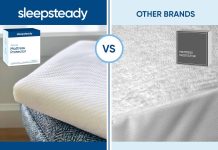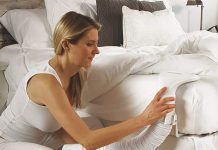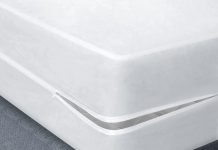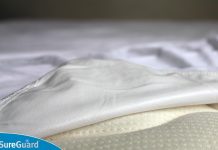If you’ve recently invested in a memory foam mattress, you may find yourself pondering over whether or not you need a mattress protector for it. Well, let us put your mind at ease. In this article, we will explore the importance of using a mattress protector specifically designed for memory foam, highlighting its benefits and reasons why it’s a worthwhile investment for the longevity of your mattress. So, put your worries aside and let’s uncover the truth behind the need for a mattress protector for your memory foam mattress.
Review contents
Overview
What is memory foam?
Memory foam is a type of material that is widely used in mattresses due to its unique properties. It is known for its ability to contour to the shape of the body, providing excellent support and pressure relief. Memory foam molds to the body’s curves, ensuring that every part of the body is properly supported. This material is also known for its excellent motion isolation, making it a popular choice for couples who share a bed.
What is a mattress protector?
A mattress protector is a removable cover that is placed over the mattress to provide an extra layer of protection. It serves as a barrier between the mattress and external factors such as spills, stains, dust mites, allergens, and even bed bugs. Mattress protectors are typically made of a variety of materials, including waterproof fabrics, hypoallergenic fabrics, and breathable fabrics.
Importance of using a mattress protector
Using a mattress protector is essential for maintaining the longevity and quality of your memory foam mattress. While memory foam mattresses offer numerous benefits, they are not impervious to damage from spills, sweat, allergens, or dust mites. A mattress protector acts as a shield, protecting your mattress from these potential threats. By using a mattress protector, you can extend the lifespan of your mattress, maintain its warranty, enhance comfort, and improve hygiene.
Benefits of Using a Mattress Protector for Memory Foam
Protection against spills and stains
Accidents happen, and spills are inevitable, whether it’s a spilled drink, urine, or even pet accidents. These liquids can seep into the memory foam mattress and are not only difficult to clean, but they can also lead to the growth of bacteria and mold. By using a mattress protector, you create a barrier that prevents liquids from reaching the mattress directly, making cleaning up spills a breeze and minimizing the risk of stains and odors.
Prevention of allergens and dust mites
Dust mites and allergens are common culprits for allergies and respiratory issues. They can easily find their way into the mattress, triggering allergic reactions and worsening existing conditions. A mattress protector designed specifically for memory foam can effectively create a barrier that prevents these microscopic critters and allergens from penetrating the mattress. This promotes a healthier sleeping environment, especially for those with allergies or asthma.
Extend the lifespan of your memory foam mattress
Investing in a good quality memory foam mattress can be expensive, and you want it to last as long as possible. However, stains, spills, dirt, and oils from our bodies can all contribute to the degeneration of the mattress. With a mattress protector, you can protect your investment by reducing wear and tear, extending the lifespan of your memory foam mattress. It acts as a protective layer, shielding the mattress from daily use and potentially damaging factors.
Maintain mattress warranty
Many manufacturers require the use of a mattress protector to maintain the warranty. Without a mattress protector, any damage caused by spills, stains, or other accidents may void the warranty. By using a mattress protector, you provide an extra layer of protection, ensuring that the warranty remains valid. It’s essential to check the mattress warranty guidelines to understand any specific requirements related to the use of a protector.
Enhance comfort and hygiene
A mattress protector not only protects your memory foam mattress but also enhances comfort and hygiene. It helps to minimize the accumulation of dirt, dead skin cells, sweat, and other bodily fluids that can affect the overall cleanliness and freshness of your mattress. By using a mattress protector, you can maintain a cleaner sleeping environment and enjoy a more comfortable and hygienic night’s sleep.
Types of Mattress Protectors for Memory Foam
Fitted sheet style protectors
Fitted sheet style protectors are the most common type of mattress protector. They are designed to fit over the mattress like a fitted sheet, with elastic edges ensuring a snug and secure fit. These protectors are easy to install, remove, and clean, making them a convenient option for many users.
Zippered encasements
Zippered encasements completely encase the entire mattress, providing the highest level of protection. They are ideal for users who want complete coverage and protection against allergens, bed bugs, and dust mites. Zippered encasements can be a bit more challenging to put on and take off compared to fitted sheet-style protectors, but they offer unparalleled protection.
Waterproof protectors
Waterproof protectors are perfect for individuals who are prone to spills or bedwetting. These protectors are specifically designed to repel liquid, preventing it from seeping into the mattress. They are typically made of materials that are impermeable to liquids, such as vinyl or polyurethane. Waterproof protectors are easy to clean and maintain, ensuring that your mattress stays dry and free from damage.
Hypoallergenic protectors
Hypoallergenic mattress protectors are designed to prevent allergens and dust mites from infiltrating your mattress. They are made of materials that are resistant to allergens, such as tightly woven fabrics or those treated with antimicrobial agents. These protectors provide an added layer of defense for individuals with allergies or respiratory sensitivities, promoting a healthier sleep environment.
Considerations When Choosing a Mattress Protector for Memory Foam
Breathability and heat regulation
When selecting a mattress protector for memory foam, it is essential to consider its breathability and heat regulation properties. Memory foam tends to retain heat, so choosing a protector that allows for proper airflow and heat dissipation is crucial. Opt for protectors made with breathable fabrics that promote air circulation, helping to keep you cool and comfortable during the night.
Ease of cleaning and maintenance
A mattress protector should be easy to clean and maintain to ensure its longevity. Look for protectors that are machine-washable and can withstand frequent washing without losing their effectiveness. Additionally, consider protectors that are dryer-safe or easy to air dry. The ease of cleaning and maintenance will make your life easier and allow you to keep your mattress protector in optimal condition.
Noise and odor
Some mattress protectors can produce noise or odors that may disrupt your sleep experience. It’s important to choose a protector that is noiseless, especially if you are a light sleeper. Additionally, opt for protectors that are odor-free or have minimal off-gassing to ensure a pleasant sleeping environment.
Compatibility with adjustable bases
If you have an adjustable bed base, it’s crucial to choose a mattress protector that is compatible with it. Make sure the protector can stretch and adapt to the movements of the adjustable base without compromising its protective qualities. Always check the product specifications or consult with the manufacturer to ensure compatibility.
Elasticity and fit
A well-fitting mattress protector is essential to ensure proper protection and comfort. Look for protectors with elasticized edges or deep pockets, as they provide a snug and secure fit. This will prevent the protector from moving or slipping off the mattress during the night, ensuring continuous protection.
How to Properly Use a Mattress Protector for Memory Foam
Prevent installation mistakes
To properly use a mattress protector for memory foam, it’s important to avoid installation mistakes. Start by carefully reading the manufacturer’s instructions and following them step-by-step. Take the time to properly align and fit the protector on your mattress, ensuring that it covers the entire surface without any wrinkles or gaps.
Secure the protector properly
Once the mattress protector is in place, be sure to secure it properly. Check for any loose corners or edges and adjust accordingly. This will prevent the protector from shifting or slipping during sleep, maintaining its protective qualities.
Regularly clean and maintain the protector
To ensure the longevity and effectiveness of the mattress protector, it’s important to clean and maintain it regularly. Follow the manufacturer’s cleaning instructions and wash the protector as recommended. Regularly cleaning the protector will help remove any dirt, allergens, or stains that may have accumulated over time, keeping your mattress protected and fresh.
Alternative Options to Mattress Protectors for Memory Foam
Fitted sheets
While not specifically designed for protection, fitted sheets can provide a basic level of defense against stains and spills. They can help prevent direct contact between your body and the mattress and are relatively easy to clean. However, fitted sheets may not offer the same level of protection as a dedicated mattress protector and may not provide coverage against allergens or bed bugs.
Mattress toppers
Mattress toppers are another option that can offer some protection for your memory foam mattress. They are typically thicker than mattress protectors and can provide an extra layer of cushioning and comfort. However, mattress toppers may not fully protect the mattress from spills, stains, or allergens. It’s important to consider your specific needs and preferences when choosing between a mattress protector and a mattress topper.
Frequently Asked Questions
Is a mattress protector necessary for memory foam?
While not mandatory, using a mattress protector for memory foam is highly recommended. It offers numerous benefits, including protection against spills, stains, allergens, and dust mites. A mattress protector can also help maintain the longevity of your mattress and preserve its warranty.
Can a mattress protector affect the feel or firmness of memory foam?
A good-quality mattress protector should not significantly alter the feel or firmness of your memory foam mattress. However, it’s essential to choose a protector that is specifically designed for memory foam to ensure compatibility and optimal comfort.
Do mattress protectors make noise?
Not all mattress protectors make noise. Look for protectors that are noiseless or have a noise-reducing feature if you are sensitive to sound while sleeping.
Can I use a regular mattress protector on memory foam?
It is generally recommended to use a mattress protector that is specifically designed for memory foam. Regular mattress protectors may not provide the same level of protection or may not be compatible with the unique properties of memory foam.
How often should I clean a mattress protector?
It is recommended to clean your mattress protector regularly, following the manufacturer’s guidelines. Typically, it is advisable to wash the protector every 1-2 months or as needed. However, if you experience spills, stains, or allergen exposure, it may be necessary to clean the protector more frequently.
Conclusion
Investing in a memory foam mattress is a significant decision, and protecting that investment is equally important. Using a mattress protector for your memory foam mattress offers numerous benefits, including protection against spills, stains, allergens, and dust mites. It can also help extend the lifespan of your mattress, maintain its warranty, enhance comfort and hygiene, and provide peace of mind. With a wide range of options available, choosing the right mattress protector for your needs and preferences is essential. Remember to consider factors such as breathability, ease of cleaning, noise and odor, compatibility with adjustable bases, and the fit of the protector. By following proper installation and maintenance practices, you can maximize the benefits of a mattress protector and ensure a clean, comfortable, and protected sleep experience on your memory foam mattress.































